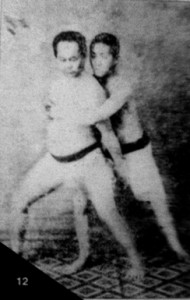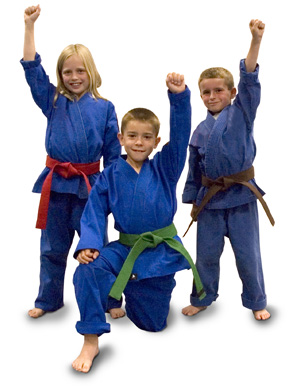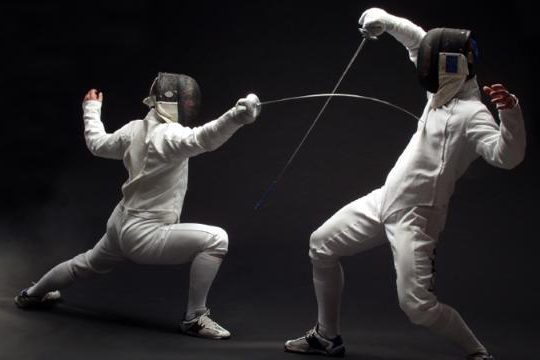It goes without saying that we’re all in this Karate thing for various reasons.
- Some of us want to execute kata after kata until the break of dawn.
- Some of us want to smack people in the mouth in furious kumite sessions all night long.
- Some of us want to drill basic punches and kicks up and down the dojo like there’s no tomorrow.
- Some of us want to forget work and just relax with a bit of training and socializing.
And then… some of us simply want to figure this whole mythical kata “bunkai” thingy out, once and for all.
This post is for that last category of Karate peeps.
Kata application affecionados.
Those of us who feel it’s time to dive deeper into the abysmal void of kata and its enigmatic application practises.
In other words, what we today generally refer to as “bunkai” in Japanese.
Or, using the universal language of mathematics:
- Bun = “segment”, “part”
- Kai = “understand”, “explain”
- Bun + Kai = BUNKAI = “disassembly”, “analysis“
Kata analysis.
Awesome.
But, unfortunately, this is as far as most people get. They hear the phrase “kata application” and go; “oh, hey, awesome, “bunkai”, great; let’s analyze and really understand the practical meaning of some kata moves”, and then go on with business as usual (perhaps after unsuccessfully trying to defend themselves with move X from kata Y against either a) a straight punch or b) a straight kick.)
But you and I know that’s not how it works.
Oh no…
See, the problem is, most people have no idea where or how to properly start digging for those real bunkai nuggets!
I mean, just look at this e-mail I got the other week [edited]:
Hi Jesse-san,
I have read and reread most of your postings at your site as I am a big fan of your wrtiting style, as well as your insights.
Recently I reread the post titled 7 Reasons Why Your Bunkai (Probably) Sucks (also the follow-up 5 (More) Reasons Why Your Bunkai (Still) (Probably) Sucks) and one of your points about “chosing the wrong kata makes it difficult to get good bunkai” made me want to ask you a question:
Is there any “safe” kata to go and learn if you want to extract viable combat techniques from it/them?
Do you know any kata you would call “key” kata? If you do which version do you find most interesting and why? From a self proclaimed “Taekwondo Nerd” to a self proclaimed “Karate Nerd”
Eagerly awaiting your thoughts,
Best regards from Ørjan
All right.
I knew this day would come sooner or later…
Ready?
Here we go.
Presenting, “Jesse’s Super Functional 4-Step Guide to Choosing the Right Kata for Your Next Bunkai Adventure”, where I’ll quickly guide you through some of the most overlooked steps when starting to investigate kata bunkai (applications). You’ve finally decided that it’s time to stop acting like you’re doing some kind of rain dance and actually put some meaning into the movements of your Karate kata? Cool. But where do you start? What kata to choose? How to choose?
That’s what I’m here to help you with.
Just follow these four dead-easy steps for a fool-proof, 100% money back, guaranteed way of ending up with a kata you can work with in your quest for applicational kata enlightenment.
(Obviously there’s more to it than just four steps, but I think these are often neglected.)
Hajime:
Step 1: Know Your Frickin’ Karate History
So…
You really thought a kata named Gekisai, Taikyoku, Fukyu or Kihon-kata was a good chice, didn’tcha?
Well, somebody should have done you a favor and shoved a Beginner’s Karate History for Dummies down your throat. Why? Because some of those kata might not even have a cool “street-fighting style” bunkai in the first place! Created in the middle/later part of the 20th century, some particular kata were actually made explicitly for stuff like; teaching frail school children, improving physical education, fostering national health/pride or simply being “cool”!
Yeah, you read that right.
There were actually kata created (Uechi-ryu springs to mind) with the main purpose of looking “flashy”, so as to bring some more money to poor WW2 Karate practitioners forced to appear in public demos simply to get food on the table (if you’ve ever seen a classic Kung-fu movie where a medicine hawker flashes his skills at the local town square for spare change, you know what I’m talking about)!
The truth is, many kata were made for reasons far beyond civil self-defense (which, unfortunately, is exactly what we’re looking for) so before you run off and try to find a defense against a plain ol’ dirty headbutt, a counter to a vicious lapel grab/hook punch or escape from a rear choke in your favorite kata, consider the history of the kata in question.
No, a kata named Fukyugata Ichi (lit. “dissemination form, no. 1”) created by Nagamine Shoshin in 1941 for the sole purpose of spreading and (hopefully) unifying Karate throughout Okinawa/Japan is probably not going to be of much help at the moment.
No, an original Shorin-ryu kata brought from Okinawa to mainland Japan by a teacher named Funakoshi Gichin in the early 1900’s only to be rebranded and rearranged into a Shotokan creation by youthful first /second generation students who would rather spend their time doing high kicks and 360° jumps than learning joint locks, dirty boxing and takedowns (three common ingredients of Okinawan Karate) is probably not going to help you much unless you actually believe a self-defense scenario consists of… well, high kicks and 360° jumps. One does not need to be a rocket scientist to recognize the enormous ambiguity surrounding the kata, and the dysfunctionality of those application practices, as handed down by the students of Mr. Funakoshi.
And finally, no, a kata codified by Itosu Anko, “the father of modern Karate” in his turn of the century maniac quest for making Karate the #1 source of national pride in aiding Japan’s escalating war machine during WW2, through removing basically every practical (read: “fun”!) Karate technique known to man, will not get you a single step further in finding eye-pokes, fish-hooks, groin kicks and ear slaps in your quest for awesome bunkai study material.
Watered-down kata will, undoubtedly, leave you with watered-down bunkai.
Which leaves us with… what?
I’ll tell you what:
A handful of cool, no holds barred, kata that you can actually work with.
(Without needing to come up with “secret”, “invisible” or “hidden” techniques to actually get the stuff to work properly! More here.)
So get your history straight, dawg.
And then choose your kata.
Step 2: Look at Other Styles, Masters and Schools
All right.
Let’s say you’ve singled out a couple of awesome supposedly “old-style” kata that you’re confident will work wonderfully when you start to analyze them. You might even have learnt them in Okinawa yourself (which, certainly, is no guarantee that a kata is “awesome” – considering the massive reverse influence of modern Karate back to Okinawa. More on the ‘Okinawan Karate Myth’ here. But I digress).
So, with only a handful of workable kata at your disposal, which one should you choose?
Here’s where I would look at other styles.
See, it is pretty logical to assume that that once you really begin to think deeply about the possibilities inherited in the applications of a certain kata, you will get stuck. You will fall back into your old habits of thinking inside the notorious box.
So stop trying to fit the proverbial 10 pounds of manure in a 5 pound bag… and expand your horizon, young grasshopper.
Look at other styles.
Secretly Openly inquire about other lineages, masters, dojos and organizations.
And then choose a kata you find in as many places as possible.
Why?
Because you can be pretty sure that a kata existing in various forms in various parts of the Karate world has been pretty dissected by people of various skills way before you ever thought of doing the same.
So use that to your advantage.
Here’s three brief examples of various flavors of kata existing in several styles (bearing the same root name):
- Bassai (Dai/Sho/Tomari/Matsumura/Oyadomari…)
- Kusanku (Dai/Sho/Shiho/Chatan Yara/Matsumura…)
- Seisan (Naha, Shuri, Aragaki, Uechi…)
Your spelling may vary.
The cool thing is, even though these kata exist in different styles and branches of the Karate tree, and even though they might even have changed name during the evolution of Karate (like Seisan>Hangetsu in the list above), the same basic meaning of the movements (bunkai) has often been amazingly well-preserved.
Sure, the height of a certain punch might have shifted, or the length of a certain stance might have been adjusted… but 9 times out of 10 that’s just aesthetics!
For those who can look beyond the form, the function has rarely changed.
Sadly, many people can’t see the forest for the trees though.
(Which has created what people nowadays refer to as “style bashing”.)
So, for ensuring maximum chances of finding awesome bunkai to your chosen kata, through cross-examination and comparison, try to choose a kata that is present in several styles. Or at least some style other than your own. Preferably.
Yes, this requires some detective work.
No, I won’t do it for you.
3. Count the Bunkai, Not the Steps.
Okay, so you’ve finally narrowed it down even more. Soon you’ve got a dream team of katas lined up.
However, now it’s time to be even more picky.
By counting the number of bunkai in your kata.
Not moves.
Not performance length.
Not steps.
But bunkai.
Or, “easily recognizable individual templates” (combinations of moves), if you will.
See, the thing is, if a kata is too long and complex, my bet is you will stop studying it half-way through. And we definitely don’t want that, do we? Nope, we want to finish and understand the entire kata, the whole shebang. So forget the actual number of moves in a kata and count the actual bunkai instead. The length of a performance has almost no correlation to the number of unique self-defense templates present in the kata.
Example:
Suparimpei, one of the longest kata ever invented, contains around 50-60 steps/moves. It’s ridiculous. But bunkai-wise? That’s another story.
A quick count gives roughly 10-15 or so!
Imagine that: To properly understand one of the longest and most advanced kata in Shito-ryu/Goju-ryu, you “only” need to master around ten-ish self-defense scenarios.
The cool thing is, there’s tons of much, much shorter kata (considering performance length) with almost double the amount of bunkai! Ha!
So, I guess what I’m trying to say is; when choosing a kata for your next bunkai study adventure, make sure it has a realistic amount of bunkai (which you can quickly assess by counting the individual unique combinations of moves), or you might find yourself abandoning the kata half-way through when you’re stuck.
Because, believe me, sooner or later you will get stuck.
Stuck, stuck, stuck…
4. Choose a Kata You Like Love
For some reason, people care too much what other people think.
Which is especially true in kata competitions, where choosing an unorthodox kata (and performing it well) is so frightening that people will rather pick a mainstream kata (and perform it badly).
But forget that.
The day you let a bald guy with a cheap-ass blazer and grey trousers, sitting on a chair holding two flags, decide what kata you should do… is the day your Karate stops being your own.
You’re not competing with anyone.
So chill. The Heck. Out.
If you think a kata is boring, ditch it. Pick another one. If it’s fun, keep it. If it’s boring, let it go. Don’t worry, nobody cares.
Now, of course you will eventually get tired of a kata no matter how fun it is in the beginning. But that’s in the nature of things. It is what it is, and we are what we are.
Humans.
Who get bored.
The best thing you can do is to at least allow yourself to choose the most interesting and mind-tickling kata you know, and then make a promise to yourself that you’re going to stick with this kata until you know it like the inside of your pocket, figuring it out once and for all.
And that concludes my fourth and last point in “Jesse’s Super Functional 4-Step Guide to Choosing the Right Kata for Your Next Bunkai Adventure”.
I’ll let my homie Mabuni Kenwa finish you off:
If you sufficiently study two or three kata as your own and strive to perform them correctly, when the need arises, that training will spontaneously take over and will be shown to be surprisingly effective. If your kata training is incorrect, you will develop bad habits which, no matter how much kumite and makiwara practice you do, will lead to unexpected failure when the time comes to utilize your skills. Correctly practicing kata – having sufficiently comprehended their meaning – is the most important thing for a karate trainee.
– Mabuni Kenwa, “Practise Kata Correctly“.
Betta recognize.



17 Comments